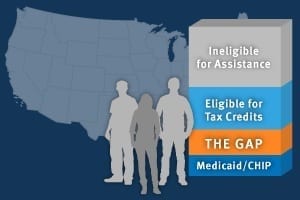I’ve found the Henry J. Kaiser Family Foundation to be a useful source of information on all kinds of health care topics, including its website’s new section profiling each of the 50 states on this question: “How will the uninsured fare under the Affordable Care Act?”
As the site notes, the 2010 act “has the potential to extend coverage to many of the 47 million nonelderly uninsured people nationwide.” That number includes, as examples, 70,000 uninsured North Dakotans; 301,000 Iowans; and seven million Californians.

The legislation’s impact across the U.S. will vary based on a number of factors. A big one may be whether a state has chosen to implement expansion of Medicaid, which the Supreme Court made optional for states in its June 2012 ruling. One intent of the Affordable Care Act (ACA) is to give low-income people coverage through Medicaid, which of course won’t be an option for those adults in “non-expansion” states. People who fall into a “coverage gap” of earning too much to qualify for Medicaid (however it’s administered in their state) but not enough to qualify for premium tax credits are ineligible for financial assistance under the ACA.
“Because they do not gain an affordable coverage option under the ACA, they are most likely to remain uninsured,” the foundation states.
That could be especially harmful to the uninsured in non-Medicaid expansion states with high poverty rates, like Mississippi and Louisiana. According to the U.S. Census Bureau (2012), the poverty rate in Mississippi is 24.2 percent, the nation’s highest; in Louisiana, it’s 19.9 percent. The Kaiser Foundation site notes that among uninsured Mississippians, 30 percent fall in that coverage gap; among uninsured Louisianans, 28 percent do.
By contrast, another high-poverty-rate state, New Mexico (20.8 percent), will implement the Medicaid expansion. The Kaiser Family Foundation predicts more than seven in 10 uninsured nonelderly adults in New Mexico are eligible for financial assistance to get coverage through either Medicaid or the new Marketplaces.
Interestingly, two states with the lowest poverty rates, New Hampshire and Alaska, aren’t expanding Medicaid, either. The foundation estimates 16 percent of uninsured New Hampshire adults and 13 percent of uninsured Alaskans fall into the coverage gap.
How will this and all other aspects of the ACA play out in the months and years ahead? As the Kaiser Family Foundation site points out, only time will tell.
“There is no deadline for state decisions about implementing the Medicaid expansion, and open enrollment in the Marketplaces continues through March 2014,” it states. “Continued attention to who gains coverage as the ACA is fully implemented and who is excluded from its reach — as well as whether and how their health needs are being met — can help inform decisions about the future of health coverage” in each state.

